Commercial trash compactors play a key role in the waste programs for many of today’s companies. Having a solid understanding of this machine is critical for those involved in solid waste management. This guide to commercial trash compactors will answer the following questions:
- What Is A Commercial Trash Compactor?
- What Are The Components Of A Commercial Trash Compactor?
- How Does A Commercial Trash Compactor Work?
- What Are The Benefits Of Using A Commercial Trash Compactor?
- How Do Commercial Trash Compactors Save You Money?
- How Do Commercial Trash Compactors Prevent Unauthorized Access To Your Trash?
- How Do Commercial Trash Compactors Reduce Environmental Impact?
- How Do Commercial Trash Compactors Improve Your Property’s Cleanliness And Safety
- How Do Commercial Trash Compactors Extend Your Pavements Lifespan?
- How Do Commercial Trash Compactors Increase Your Workforce’s Productivity?
- How Do Commercial Trash Compactors Save Space?
- How Do Commercial Trash Compactors Reduce Fire Hazards?
- What Can You Put In A Commercial Trash Compactor?
- What Are The Different Types Of Commercial Trash Compactors?
- What Is A Stationary Compactor?
- What Is A Self-Contained Compactor?
- What Is An Apartment Compactor?
- What Is A Vertical Compactor?
- What Is A Pre-Crusher Compactor?
- What Is A Transfer Station Compactor?
- What Are The Key Considerations When Planning For A Commercial Trash Compactor?
- What Is My Current Arrangement With My Waste Hauler?
- What Type Of Business Do I Run?
- What Is My Waste Material?
- What Is My Volume Of Trash?
- What Is The Location Of My Trash?
- Is My Property Equipped To Handle A Commercial Trash Compactor?
- How Do I Want To Pay For The Commercial Trash Compactor?
- What Do I Want To Get Out Of Using A Commercial Compactor? What Is My Goal?
What Is A Commercial Trash Compactor?
A commercial trash compactor, sometimes called an “industrial trash compactor”, is a powerful machine that compresses and crushes waste material, reducing its size and volume. This can help businesses save money on collection costs by reducing the number of required hauls. Additionally, compactors are designed to prevent unauthorized access to waste and recyclables, keeping your premises clean and secure. Some compactors even feature advanced technologies, such as automatic sensors, that can optimize their performance and reduce their environmental impact. By investing in a commercial trash compactor, your business can enjoy improved efficiency, safety, and sustainability.
What Are The Components Of A Commercial Trash Compactor?
A commercial trash compactor is made up of the following components:
- Body– The steel structure that houses all the components of the compactor.
- Ram– The steel press that packs the waste horizontally into the container.
- Cylinder– The hydraulic component, attached behind the ram, which moves the ram forward and backward.
- Breaker Bar– A heavy-duty steel bar across the front of the compactor that breaks or folds material as the ram pushes it forward.
- Power Unit– Controls the compactor. Contains a control panel, hydraulic fluid tank, pump, electric motor, and directional control valve. The pump sends hydraulic fluid into the cylinder at high pressures, pushing the ram forward and backward.
- Charge Box– The area in the front part of the compactor into which waste material is loaded. Measured in cubic yards.
- Clear Top Opening– The length and width of the access opening into the charge box.
- Proximity Switch– A switch that changes the direction of the pump to extend and retract the ram.
- Container- The large steel section where the compacted trash is stored. This section is built either separately or as an integral part of the machine depending on the type of compactor.
How Does A Commercial Trash Compactor Work?
How commercial trash compactors work varies slightly by the specific type of compactor and brand, but in a general sense the process works like this:
- Waste & recyclable materials are loaded through the compactor’s clear top opening into the charge box.
- The cycle begins either automatically through an automatic cycle control system or manually by the compactor operater turning the switch/key on the control panel.
- This prompts the pump to send hydraulic fluid into the cylinder at high pressure which moves the ram forward and compacts the materials into the compactor’s container.
- The resulting compacted waste is then stored in the container until it is collected for disposal by a waste hauler.
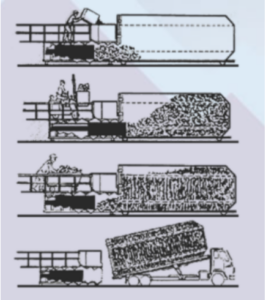
What Are The Benefits Of Using A Commercial Trash Compactor?
Commercial trash compactors provide numerous financial, operational, and environmental benefits. They are key to a successful waste-handling operation. Any business that produces a high volume of waste should consider them. Some of the key benefits include: saving you money, preventing unauthorized access to your trash, reducing environmental impact, improving your property’s cleanliness & safety, extending your pavements lifespan, increasing your workforces productivity, saving space, and reducing fire hazards.
How Do Commercial Trash Compactors Save You Money?
Even though the initial price of a commercial compactor is higher than other waste equipment options like an open-top dumpster, it may still ultimately be the more attractive option financially. This is because of the substantial impact they can have on lowering your waste bill. Using a trash compactor reduces hauls by about 75% in comparison to an equally sized open-top container. Fewer hauls equals a lower waste bill, so if you produce a high enough volume of waste, a trash compactor will pay for itself and then some.
How Do Commercial Trash Compactors Prevent Unauthorized Access To Your Trash?
From dumpster divers getting sensitive information to neighboring businesses disposing of their waste in your containers, unauthorized access to your trash can cause a range of issues. A trash compactor’s enclosed design curbs scavenging, prevents unauthorized disposal, and keeps access to your trash completely under your control.
How Do Commercial Trash Compactors Reduce Environmental Impact?
Commercial compactors reduce environmental impact in several ways. They reduce landfill space, which helps preserve natural habitats. They also improve air quality by reducing hauling frequency from garbage trucks. This means less fuel used by garbage trucks, which are a significant source of carbon emissions due to poor fuel efficiency. Less carbon emissions from garbage trucks means cleaner air for us all to breathe. Lastly, trash compactors also limit pollution through stormwater runoff. Waste material can contaminate stormwater by fluids leaking out of open-top containers. This contaminated stormwater then ends up in nearby rivers and creeks, polluting local water sources. Trash compactors prevent this problem entirely due to their enclosed design.
How Do Commercial Trash Compactors Improve Your Property’s Cleanliness And Safety?
Overflowing dumpsters, windblown trash, and strong odors are offensive to multiple senses. These issues can even lead to safety concerns like your property harboring a community of rodents carrying diseases and spreading parasites. An unkempt trash area creates an environment for rodents to thrive by providing them with a source of food and shelter. To avoid making it a health hazard to step foot on your property, it’s important to keep your trash area clean. Trash compactors are a great tool for this because they reduce the number of containers necessary, prevent easy access to your trash, and help conceal associated odors within the machine. These benefits create an environment that deters rodents, leading to a cleaner and safer property.
How Do Commercial Trash Compactors Extend Your Pavements Lifespan?
It’s pretty well known that garbage trucks can damage pavement. Their impact is equivalent to about 2,000 cars! Heavy trucks moving slowly strains pavement by causing bends and cracks in the asphalt. Using a trash compactor extends your property’s pavement life by reducing the number of visits from these heavy garbage trucks.
How Do Commercial Trash Compactors Increase Your Workforce’s Productivity?
Trash compactors are relatively simple and efficient machines. There’s no need to break down waste before using and they’re often fed off a loading dock or through a chute, which eliminates the need for employees to leave the building when taking out the trash. Of course, not all compactors are dock or chute fed, so this depends on the specific application, but overall, they increase a workforce’s productivity by reducing the amount of time and effort spent on non-revenue generating activities like waste handling.
How Do Commercial Trash Compactors Save Space?
Commercial compactors save space by reducing the number of containers needed for storing waste at a facility. A facility that has 8 containers throughout its parking lot might be able to cut that down to one compactor. That opens up valuable space for things like parking or other revenue-generating assets.
How Do Commercial Trash Compactors Reduce Fire Hazards?
Oxygen is essential to combustion. Compaction squeezes the air out of waste which means loose trash catches fire easier than compacted trash. Open containers expose your trash to outside elements, from people discarding cigarette butts to arsonists. Using a trash compactor helps reduce trash-related fire hazards because it removes oxygen in your waste and prevents exposure to outside elements.
What Can You Put In A Commercial Trash Compactor?
You can typically put a variety of items in a commercial trash compactor. Some common examples include general waste, such as paper, cardboard, plastic, food scraps, and packaging materials. Additionally, fabrics, clothing, bedding, hygiene products, aluminum cans, Styrofoam, non-hazardous medical waste, pallets, crates, appliances, furniture, and defective products are often acceptable for compaction.
However, it’s important to note that the specific capabilities and restrictions of a compactor can vary. The materials you can dispose of depend on the specific type of compactor. In general, compactable materials are categorized into three waste types: dry, wet, and bulky. This classification helps determine the most suitable compactor for handling the waste.
For a more in-depth look at the types of materials you can put in a commercial trash compactor check out our blog post “What Type of Waste Can You Put In a Compactor?“.
What Are The Different Types Of Commercial Trash Compactors?
In order to meet the unique waste handling needs of companies across all industries, there are several different types of commercial trash compactors. Six of the most common types are: Stationary Compactors, Self-Contained Compactors, Apartment Compactors, Vertical Compactors, Pre-Crusher Compactors, and Transfer Station Compactors.
What Is A Stationary Compactor?
A stationary compactor is a heavy-duty machine that compresses dry waste & recyclables into a dense, easily transportable form. Items like cardboard, paper, plastics, non-ferrous metals, and general trash are suitable for this machine. Unlike other types of compactors, such as self-contained, a stationary compactor is separate from the compaction container, which is hauled away to the landfill or recycling center for disposal. With their powerful hydraulic systems and sturdy construction, stationary compactors can help businesses save money on disposal costs, reduce their environmental impact, and improve their overall waste management efficiency.
Stationary Compactors are manufactured in multiple different sizes, but units between 2 and 5 yards are most common. These units often come standard with a separate 40-Yard compactor container.
Stationary Compactors are common at: schools, distribution centers & warehouses, manufacturing plants, thrift stores, retail stores, automotive dealerships and more.
What Is A Self-Contained Compactor?
Self-Contained Compactors are trash compactors that handle high volumes of wet waste. Items like food waste, organic material, and any waste containing liquid. Self-Contained Compactors are single units with the container. During pick-up, the compactor and container are both taken by the hauler to be dumped.
Self-Contained Compactors are manufactured in multiple different sizes from 15 to 39 yards. 30-yard and 35-yard units are the most common sizes.
Self-Contained Compactors are common at: grocery stores, garden-style apartment complexes, restaurants, schools, manufacturing plants, retail stores, hospitals , hotels & resorts, senior living facilities, convenience stores & gas stations, stadiums & arenas and more.
What Is An Apartment Compactor?
Apartment Compactors, sometimes referred to as high-rise or chute compactors, are trash compactors that handle trash for buildings with indoor trash rooms with limited space.
Apartment compactors are most commonly manufactured to be about 2 yards long. These units pack waste into separate 2-4 yard mobile receiver containers that roll to the curb for pick-up.
Apartment Compactors are common at: high-rise apartment complexes, hospitals, hotels & resorts, senior living facilities, convenience stores & gas stations, stadiums & arenas and more.
What Is A Vertical Compactor?
Vertical Compactors, sometimes referred to as compacting dumpsters, are trash compactors that handle trash in areas where space is limited. They can be solutions for both dry and wet waste. The compactor ram packs down vertically as opposed to horizontally, like all other compactors.
Vertical compactors are most commonly manufactured to be a little less than 3 yards tall. These units pack waste into separate 4, 6, and 8-yard mobile receiver containers that roll to the curb for pick-up.
Vertical Compactors are common at: grocery stores, garden-style apartment complexes, restaurants, schools, retail stores, hospitals, hotels, senior living facilities, gas stations, stadiums & arenas and more.
What Is A Pre-Crusher Compactor?
Pre-Crusher Compactors are trash compactors that handle bulky waste. Items like pallets, crates, and white goods. They are also a good solution for defective product destruction. Pre-Crushers are similar to stationary compactors, but with a retractable steel wall at the end of the charge box. The ram crushes material against this steel wall. Then the steel wall lifts and the crushed material packs into the receiving container.
Pre-Crusher Compactors are manufactured in multiple different sizes, but 4 and 5-yard units are most common. These units often come standard with a separate 40-Yard compactor container.
Pre-Crusher Compactors are common at: distribution centers & warehouses, manufacturing plants, thrift stores, automotive dealerships and more.
What Is A Transfer Station Compactor?
Transfer station compactors are trash compactors that handle extremely high volumes of waste and pack waste directly into a transfer trailer.
Transfer Compactors are most commonly between 12 and 15 yards. These units pack material into transfer trailers that commonly hold around typically 100 cubic yards of waste.
They are built specifically for waste transfer stations, which are facilities where waste is held, sorted, and transferred to long-haul trucks or other means of transportation for disposal or recycling.
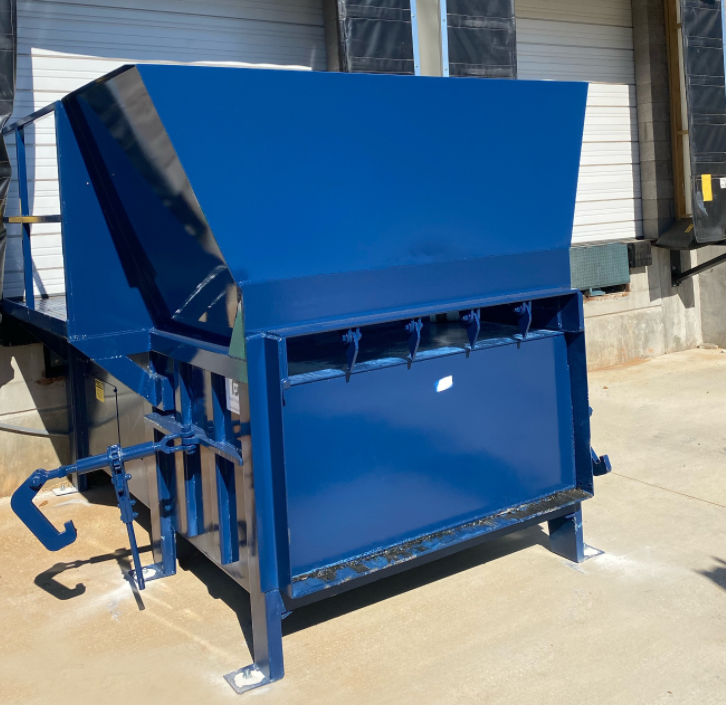
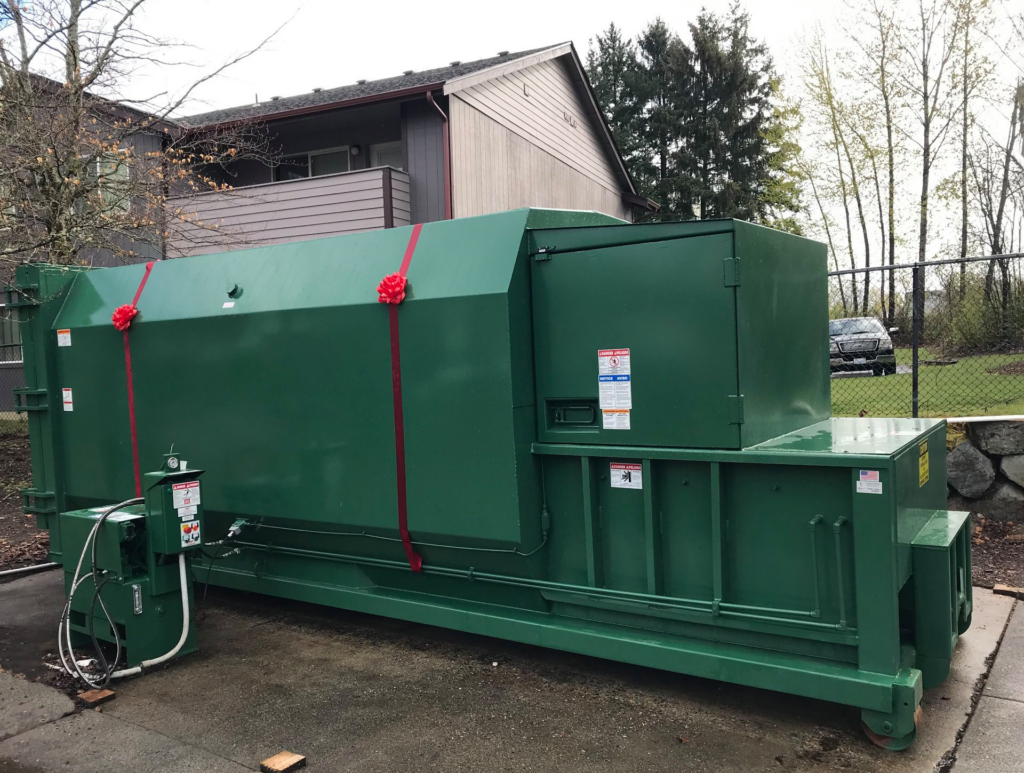
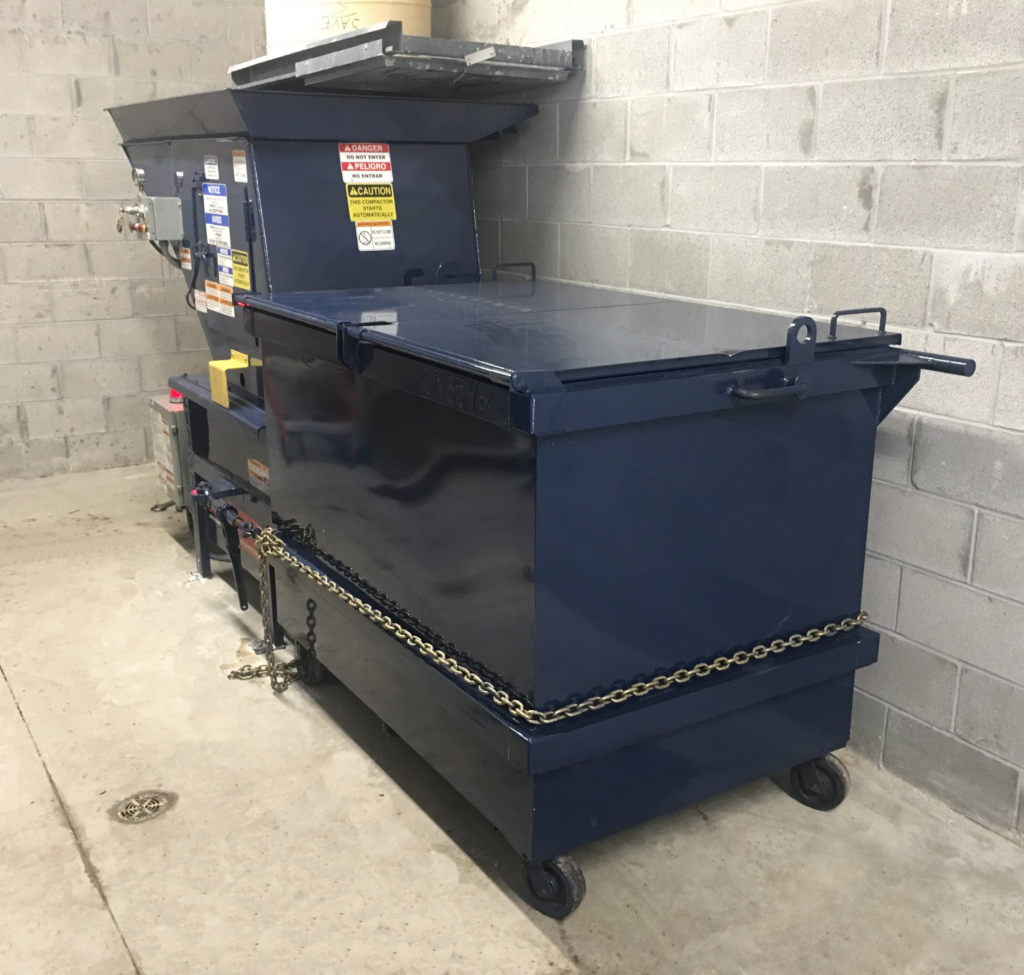
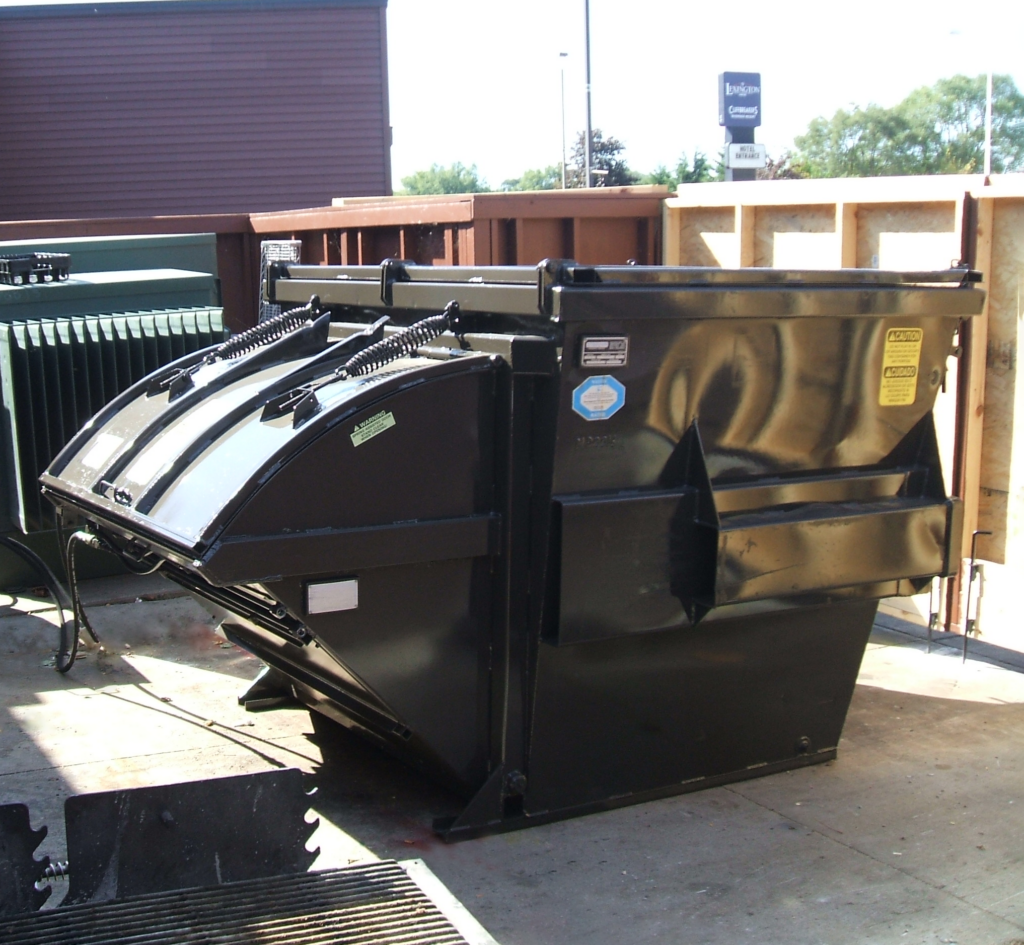
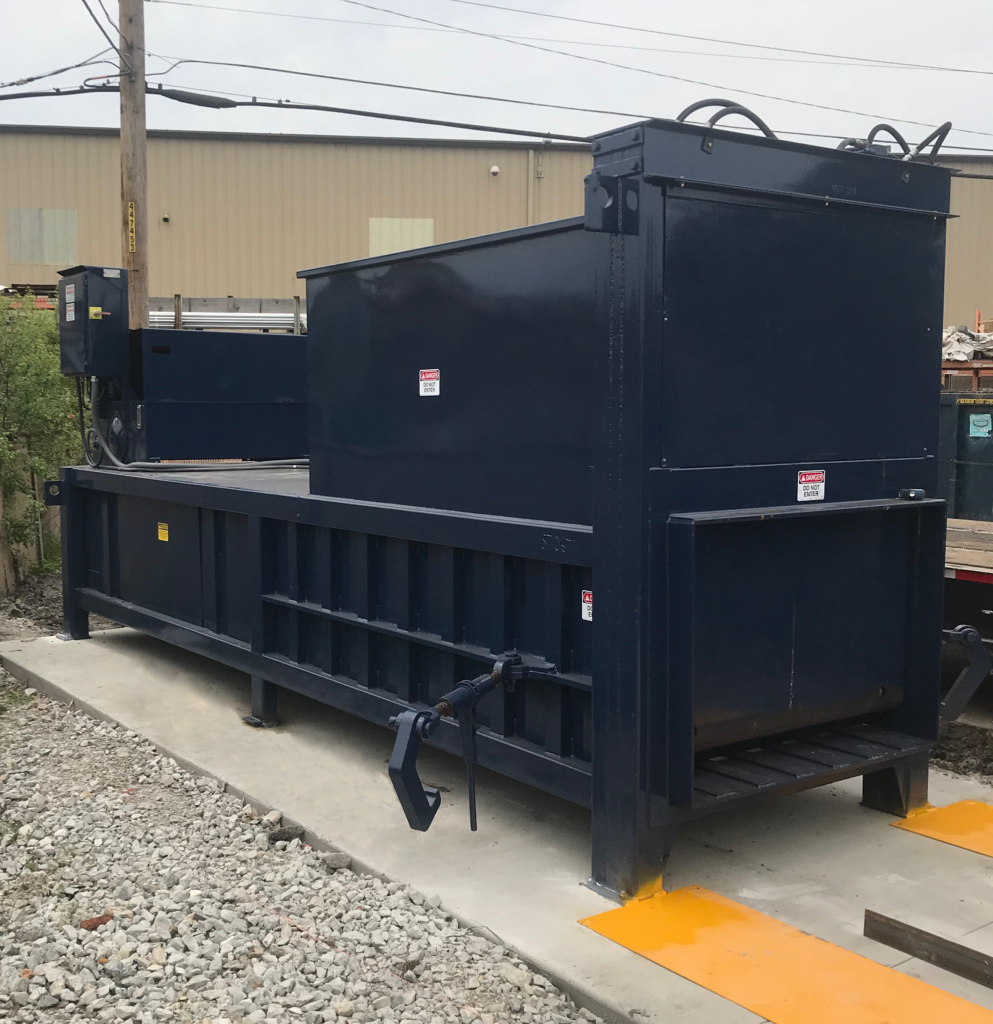
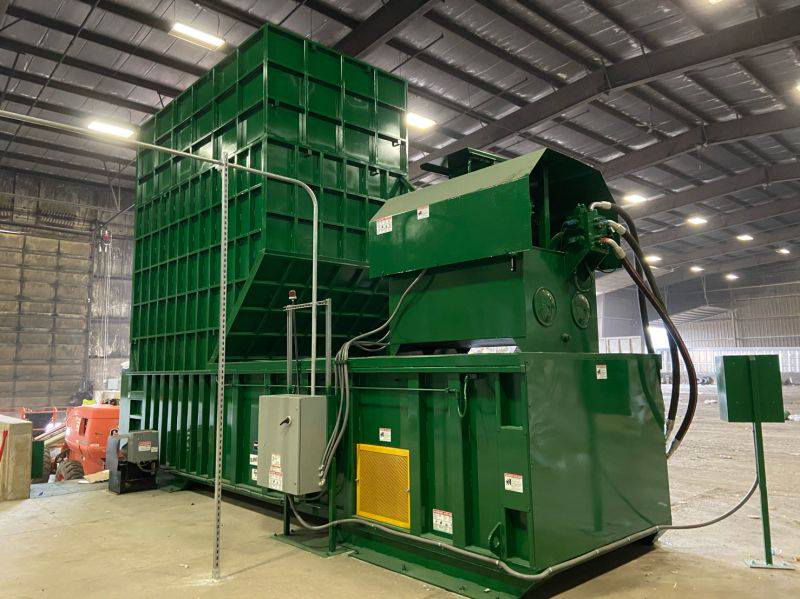
What Are The Key Considerations When Planning For A Commercial Trash Compactor?
Planning for a commercial trash compactor requires careful consideration of various factors. Each business has unique needs, and there is no one-size-fits-all solution. Here are some key considerations to keep in mind: the type of business, the type of waste material, the volume of trash, the location of the trash, if the property is properly equipped for a compactor, payment options for the compactor, and what the goal is for using the compactor. By considering these key factors, you can make informed decisions when planning for a commercial trash compactor that best meets your application.
What Is My Current Arrangement With My Waste Hauler?
Determine the specifics of the service agreement contract with your waste hauler (month-to-month, quarterly, ect.) After that, figure out how much you are currently being charged per month by your hauler and how those costs break down (pick-ups, equipment rentals, landfill charges).
What Type Of Business Do I Run?
Consider the nature of your business, such as an apartment complex, school, hospital, distribution center, or manufacturing facility. While every situation is different, businesses in the same industry often share similar needs. For example, distribution centers generate high volumes of packaging waste, while apartment complexes produce large amounts of household trash. Understanding your specific requirements will help determine the most suitable equipment.
Interested to see what equipment is best for you? Check out who we serve here, or reach out to see how we can help with your unique needs.
What Is My Waste Material?
Identify the type of waste you need to manage. Categorize it as wet waste (food items, soiled packaging), dry waste (recyclable materials like paper, plastic, aluminum), or bulky waste (large items such as pallets, furniture). Different waste types may require specific compactor solutions. For instance, self-contained compactors are ideal for wet waste, stationary compactors work well for dry waste, and pre-crushers are suitable for bulky waste. It’s important to note that compactors may not be suitable for hazardous waste, flammables, explosives, concrete, etc.
What Is My Volume Of Trash?
Determine the amount of trash your business generates each week. Calculate this by multiplying the number of containers by the number of times each container is emptied per week. Then, multiply the result by the size of the containers. For example, if you have two 6-yard containers emptied twice a week, you generate approximately 24 cubic yards of trash per week. Knowing your trash volume helps in selecting the right compactor capacity.
What Is The Location Of My Trash?
Decide where to place the trash compactor on your property. Consider whether it will be against a loading dock, inside an enclosure, or indoors/outdoors. Different locations have specific space requirements that need to be met.
Is My Property Equipped To Handle A Commercial Trash Compactor?
Ensure that your property meets the necessary requirements for a commercial trash compactor. Concrete pad requirements typically involve 6-inch thick steel-reinforced, 3000 psi concrete that is at least 10 feet wide and 5 feet longer than the combined length of the compactor and container. Additionally, determine the electrical power supply (single-phase or three-phase) needed for the compactor. Space requirements for the compactor will depend on the type of compactor and the hauler’s pickup requirements.
How Do I Want To Pay For The Commercial Trash Compactor?
Decide whether you prefer to purchase or rent the commercial trash compactor. Purchasing offers total control over the equipment and eliminates monthly rental payments. However, it requires a significant capital expenditure. Renting, on the other hand, involves operational expenses but provides maintenance and installation services. Consider your financial situation and priorities to choose the best payment option.
What Do I Want To Get Out Of Using A Commercial Compactor? What Is My Goal?
Clearly define your objectives for using a commercial compactor. Are you looking to save money on waste hauling bills, prevent employee pilferage, or improve facility housekeeping? Communicate your specific goals to the account executive to ensure the chosen compactor aligns with your requirements. In some cases, businesses may not generate enough waste volume to financially benefit from a compactor, in which case alternative options like a Front Load Container or Rear Load Container may be more suitable.
Summary
This guide to commercial trash compactors gives readers a basic overview of these machines by answering the following questions:
- What Is A Commercial Trash Compactor?
- What Are The Components Of A Commercial Trash Compactor?
- How Does A Commercial Trash Compactor Work?
- What Are The Benefits Of Using A Commercial Trash Compactor?
- How Do Commercial Trash Compactors Save You Money?
- How Do Commercial Trash Compactors Prevent Unauthorized Access To Your Trash?
- How Do Commercial Trash Compactors Reduce Environmental Impact?
- How Do Commercial Trash Compactors Improve Your Property’s Cleanliness And Safety
- How Do Commercial Trash Compactors Extend Your Pavements Lifespan?
- How Do Commercial Trash Compactors Increase Your Workforce’s Productivity?
- How Do Commercial Trash Compactors Save Space?
- How Do Commercial Trash Compactors Reduce Fire Hazards?
- What Can You Put In A Commercial Trash Compactor?
- What Are The Different Types Of Commercial Trash Compactors?
- What Is A Stationary Compactor?
- What Is A Self-Contained Compactor?
- What Is An Apartment Compactor?
- What Is A Vertical Compactor?
- What Is A Pre-Crusher Compactor?
- What Is A Transfer Station Compactor?
- What Are The Key Considerations When Planning For A Commercial Trash Compactor?
- What Is My Current Arrangement With My Waste Hauler?
- What Type Of Business Do I Run?
- What Is My Waste Material?What Is My Volume Of Trash?
- What Is The Location Of My Trash?
- Is My Property Equipped To Handle A Commercial Trash Compactor?
- How Do I Want To Pay For The Commercial Trash Compactor?
- What Do I Want To Get Out Of Using A Commercial Compactor? What Is My Goal?
Interested in learning more or have commercial trash compactor needs of your own?
